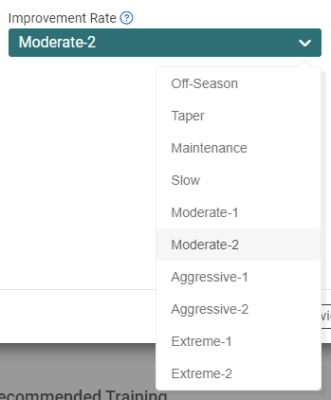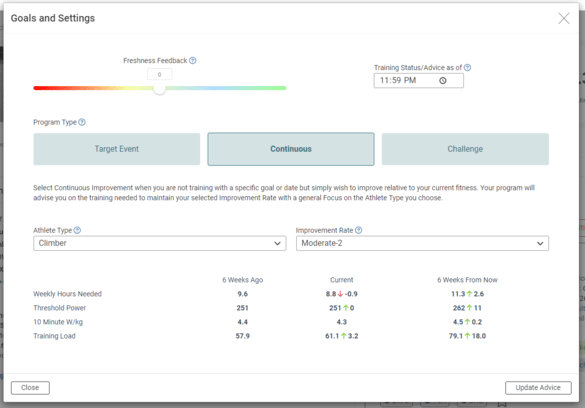This post is intended to help new users of Xert understand what Improvement Rate is and how to use it.
An important early step to getting the most out of Xert is to set your Improvement Rate (IR). Don’t worry if you don’t know what it should be! You can change it later. In fact, you should change it from time-to-time to help Xert tailor your training to your needs.

Let’s get started…
Simply put, Improvement Rate sets the rate at which Xert increases your Training Load (TL). Sounds logical, but what is Training Load? The name says it all…it’s how much training you’re doing. To get a little more technical, it’s a rolling and exponentially weighted (i.e. it puts more value on recent workouts than older ones) average of your daily XSS. Remember, your XSS takes into account the number of hours you train as well as the difficulty of your training (for example, a very hard 1 hour workout could have a higher XSS than a 2 hour easy workout). XSS is based on your Fitness Signature determined and maintained by Xert’s constant analysis of your power data.
One of the advantages of using Improvement Rate for your training, rather than following a cookie-cutter training plan, is that it dishes out your training based on how much Training Load you have already accumulated. So, rather than following a static plan that could even see you losing fitness, Xert is dynamic and uses your IR to improve your fitness from where you are right now, something most other training plans are unable to do.
Before we get to tips on how to use it, let’s make sure you know how to change it!
- Start on your My Fitness page and select the GOALS tab on the right-hand side to access the Goals & Settings dialogue.
- Find the section titled Improvement Rate, and click the drop-down menu to change your selected Improvement Rate. The options range from Off-Season to Extreme-2.
- As you change your IR, you’ll see the number of training hours required and your projected fitness values update.

Here are some tips to help you get the most out of Improvement Rate:
- Use IR to set your training hours. We’d like to have endless training time but that’s not realistic. And it probably isn’t for you either. In Xert you can use the different IR’s to change the number of hours of training per week, and the number of days of training per week, to suit your available time. You can even increase your IR if you have a week of nice weather coming up and want to take advantage of it. Note that we don’t recommend you change it too often, or increase it by too much, so that you don’t put more strain on your physiology than you can handle with your current fitness.
- Increase your IR for a ‘training camp’. If you plan to have a big week of rides, such as a trip to Majorca, you will want to dial up your IR. That will increase the recommended XSS each day. Don’t forget to dial your IR back down after your training camp so that you don’t over train. Once IR is reduced back down, Xert will guide you through the recovery you need to benefit from that extra Training Load.
- Taper a week or two before your goal event by decreasing your IR. As you approach your goal event, your training will move the specificity closer and closer to the Focus you selected. This process is gradual and progressive. As you enter your taper phase you should decrease your IR to give your body some extra rest. It will put more rest at the beginning than at the end of your taper phase to make sure that you’re rested and sharp for your goal date.
Lastly, we often get asked “what improvement rate should I use?” This isn’t a particularly easy answer because it’s different for everyone. However, there are a couple of things you can look at to help you. First, as mentioned above, look at the number of hours and workouts each IR gives you. Is this a lot more, or a lot less, than what you’re used to? Second, look at the details of the various IR’s here. They include helpful descriptions for each of them. One of them will likely feel right for you.
Happy Training!
P.S. For more posts for new users click the tag ‘Beginner’ below.




